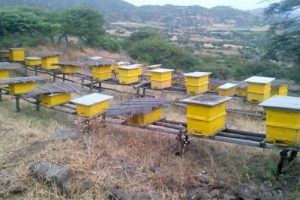
BY BILLEN SEYOUM
• For a developing country like Ethiopia with a burgeoning youth population, achieving food self-sufficiency and import substitution is a game changer.
• Previous agricultural policies have been heavily reliant on wheat productivity during the two main crop seasons known as belg and meher as well as highland production.
• Over the past three years, Prime Minister Abiy Ahmed’s government has initiated a push for production of summer wheat, adding a third cropping season.
In the past two years, Ethiopia has emerged on news headlines in an often-misleading manner in relation to the conflict in the northern part of the country. In parallel to addressing the challenges and threats posed by a belligerent rebel group, the country has been hard at work making significant progress in vast development areas. Wheat production in the agriculture sector is one such milestone.
Ethiopia’s Ten-Year Development Plan (2021-2030) identifies quality and sustained economic growth focused on key productive sectors like agriculture. As one of the productive sectors selected to accelerate economic progress, ensuring national food security is a vital national strategy. To this end, development of medium and large-scale irrigation infrastructure is being given due focus, among other contributing factors. Particularly noteworthy in this sectoral focus is the ambition to enable import substitution of key agricultural commodities like wheat.
For a developing country like Ethiopia with a burgeoning youth population, achieving food self-sufficiency and import substitution is a game changer. Highly susceptible to climate change and recurrent droughts, Ethiopia’s agricultural landscape has been fast shifting over the past three years owing in particular to an enhanced policy. Previous agricultural policies have been heavily reliant on wheat productivity during the two main crop seasons known as belg and meher as well as highland production. Over the past three years, Prime Minister Abiy Ahmed’s government has initiated a push for production of summer wheat, adding a third cropping season through utilizing medium and large-scale irrigation schemes as well as a cluster farming approach.
With the help of modern seeds, irrigation and mechanization, the government made additional efforts to reap from Ethiopia’s vast land resources. But if we were to use such inputs, we knew scale matters. As farmers pooled their lands together through clustering, they have found it easier to access and make the most of technology.
During the past Ethiopian fiscal year alone, the country has managed to produce 16.2 million quintals (1.62 billion kilograms) of irrigated wheat from over 405,000 hectares of land in the first round of cultivation. In the second round, Ethiopia cultivated 8.35 million quintals (835 million kilograms) of irrigated wheat from 208,000 hectares of land since the launch of the initiative in 2018 on a mere 3,500 hectares.
These outcomes are a direct result of proactive government commitment to direct resources to this sector. It is also a product of persistent high-level follow-up. Among the number of consecutive engagements Prime Minister Abiy Ahmed makes in any given month, follow-up on agricultural productivity is one of them. Often present in various wheat and other commodity producing sites, those engaged in the cultivation process, cite the presence, constant follow-up and intimate knowledge of the Prime Minister as encouraging to their endeavors.
While Ethiopia embarked on efforts to enhance wheat productivity in the past two years, the Covid-19 pandemic and recent Ukraine crisis have made it evident that volatility of the global commodities market greatly impacts countries like Ethiopia. As a region, East Africa is highly dependent on wheat imports, with 90 per cent sourced from Russia and Ukraine in 2020. As a year of accelerating food inflation shows us, more production doesn’t automatically translate to optimal or stable price. We also need to support cooperatives and other modern marketing institutions that facilitate for farmers to earn more and for consumers to pay less.
Ethiopia had been prone to wheat import dependency for several decades. Domestic demand for wheat has also been expanding at a slightly higher rate than domestic production. Around 29 percent of the share of expenditure by the poorest rural and 21 percent of share of expenditure by poorest urban households is directed towards the purchase of cereals including wheat. Inevitably, global commodity price shocks hit the poorest first, as has been the case with the current wheat price shock. Hence, the efforts being made in the past two years with irrigated wheat as a key driver to substitute imports are not without tangible cause.
In fact, Prime Minister Abiy Ahmed has vowed to not only substitute wheat imports by next year, but also to produce surplus for exports. Endowed with abundant arable land, the success factor in achieving self-sufficiency and wheat exports is rooted in the government’s plan of scaling up the initiative to one million hectares of land for wheat cultivation. Per Ethiopia’s Ministry of Agriculture, the scale up aims to support local food industries in fulfilling their needs with the right varieties like durum wheat.
While Ethiopia has harnessed key lessons from this particular experience, the practice of expanding sources of irrigation will be instrumental to meeting set targets. Needless to say, engagement and close monitoring of progress at the highest level of government has been and will continue to be a factor for success. The right ingredients are in place for the country to excel in the targets that have been set.
THE ETHIOPIAN HERALD FRIDAY 15 JULY 2022





